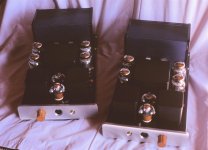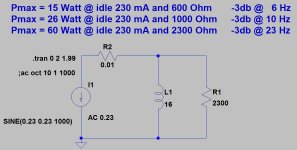Anyone heard the difference between a silicon steel core and amorphous core output transformer? I tried both single ended and push pull OPT's from Lundahl and I would say amorphous core OPT sounds a lot better that worth for the higher price that I paid. The performance of the amorphous Push Pull is even more outstanding.
Hearing is believing.
Johnny
Could you comment more on the differences as I'm considering the Lundahl amorphous core output transformers for a 300B amp vs. Hashimoto OPT's?
Basically the core lose, no load loss, is significantly lower in the amorphous core...due to low coercitivity ...
This equates to more detail passing through....small level signals can pass without turining into loss... sort of like lowering the noise floor ...
This equates to more detail passing through....small level signals can pass without turining into loss... sort of like lowering the noise floor ...
What I would like to know, is how Lundahl can make a 700W OPT at 4.5kg, compared to a Hammond 280W at 10+ kg. Both claim to go down to 30Hz. Did someone compare these two perhaps? I'm very interested in the Lundahl, since it weighs as much as the Hammind 1650T (120W), but with much more flexibility.
It's clearly wrong. 530V rms into 600R is 468W. Either the primary voltage or the power rating is wrong. I would think that voltage is right and power rating is wrong. This is true for all those combinations, including SE.
Regarding the comparison to Hammond.
As LinuksGuru said the C core can work at higher induction, up to 1.6T in this case (possibly up to 1.7 too) whereas EI starts to have too much distortion above 1.3T, actually a bit less on distortion basis. So for the same core cross-section, the EI core can withstand quite less power for the same distortion.
If EI could be used up to 1.7 T, using an EI 120 core 40x40 mm (which weights just under 2.9Kg with a total weight similar to the Lundahl) it would be possible to make a 600R/8R OT with 470W power rating @ 30Hz. But this is not possible and 250W @ 1.3T is just about the max.
Last edited:
1,746dB ll1693 600 pp
1,821dB ll1693 600 se
1,077dB ll1693 1000 pp
1,029dB ll1693 1000 se
1,684dB ll1693 2300 pp
1,636dB ll1693 2300 se
0,474dB ll1620 3300 pp
0,716dB ll1620 3300 se
0,060dB ll1620 6000 pp
0,165dB ll1620 6000 se
-0,158dB ll1620 11500 pp
0,150dB ll1620 11500 se
0,671dB ll9202 6500 pp
0,716dB ll9202 6500 se
-0,054dB ll9202 11000 pp
-0,0098dB ll9202 11000 se
0,103dB ll9202 23000 pp
0,353dB ll9202 23000 se
i think some values are more like guidelines. at high power ,copper losses will be significant
1,821dB ll1693 600 se
1,077dB ll1693 1000 pp
1,029dB ll1693 1000 se
1,684dB ll1693 2300 pp
1,636dB ll1693 2300 se
0,474dB ll1620 3300 pp
0,716dB ll1620 3300 se
0,060dB ll1620 6000 pp
0,165dB ll1620 6000 se
-0,158dB ll1620 11500 pp
0,150dB ll1620 11500 se
0,671dB ll9202 6500 pp
0,716dB ll9202 6500 se
-0,054dB ll9202 11000 pp
-0,0098dB ll9202 11000 se
0,103dB ll9202 23000 pp
0,353dB ll9202 23000 se
i think some values are more like guidelines. at high power ,copper losses will be significant
Hi,
Here are some photos of my PPP 6550 (now KT-120) mono-blocks with LL1679AM output transformers. I have been listening to and improving them for the last ten years. Note all the Lundahl iron. I made Kevin Carter, the U.S. Lundahl distributor a happy man when I started this project!
Here are some photos of my PPP 6550 (now KT-120) mono-blocks with LL1679AM output transformers. I have been listening to and improving them for the last ten years. Note all the Lundahl iron. I made Kevin Carter, the U.S. Lundahl distributor a happy man when I started this project!
Attachments
Lundahl input transformers are top notch, also some of the line output and interstage transformers. I also use a LOT of Lundahl chokes but for some reason the power output transformers suffer from rather high interwinding capacitance and are accordingly limited in their high frequency and impuls behaviour. FWIW.
LL1963 for single ended usage
Hi there,
I am also confused by the LL1693 datasheet. Its single ended version with a 450µm air gap allows 230 mA standing current and can be wired to reflect 600 Ohm, 1000 Ohm and 2300 Ohm.
According to Pa = Isquare * R maximum output power @ 600, 1000 and 2300 Ohm should be
0.230 mA square / 2 * 600 = ca. 16 Watt
0.230 mA square / 2 * 1000 = ca. 26 Watt
0.230 mA square / 2 * 2300 = ca. 61 Watt (cave low frequency response)
However, the datasheet says
140 W @ 600 Ohm
70 W @ 1000 Ohm
35 W @ 2300 Ohm
That cannot be true, because with a given current as the limiting factor the output power must increase with R and not decrease. I think it is an error when they wrote the datasheet. Probably it should say
35 W @ 600 Ohm
70 W @ 1000 Ohm
140 W @ 2300 Ohm
But this would require a standing current of sqrt (35 / 600 * 2) = 340mA.
I neglected the static resistances of the coils. Or am I that wrong???😕
Cheers
KlausB
Hi there,
I am also confused by the LL1693 datasheet. Its single ended version with a 450µm air gap allows 230 mA standing current and can be wired to reflect 600 Ohm, 1000 Ohm and 2300 Ohm.
According to Pa = Isquare * R maximum output power @ 600, 1000 and 2300 Ohm should be
0.230 mA square / 2 * 600 = ca. 16 Watt
0.230 mA square / 2 * 1000 = ca. 26 Watt
0.230 mA square / 2 * 2300 = ca. 61 Watt (cave low frequency response)
However, the datasheet says
140 W @ 600 Ohm
70 W @ 1000 Ohm
35 W @ 2300 Ohm
That cannot be true, because with a given current as the limiting factor the output power must increase with R and not decrease. I think it is an error when they wrote the datasheet. Probably it should say
35 W @ 600 Ohm
70 W @ 1000 Ohm
140 W @ 2300 Ohm
But this would require a standing current of sqrt (35 / 600 * 2) = 340mA.
I neglected the static resistances of the coils. Or am I that wrong???😕
Cheers
KlausB
Hi there,
I am also confused by the LL1693 datasheet. Its single ended version with a 450µm air gap allows 230 mA standing current and can be wired to reflect 600 Ohm, 1000 Ohm and 2300 Ohm.
According to Pa = Isquare * R maximum output power @ 600, 1000 and 2300 Ohm should be
0.230 mA square / 2 * 600 = ca. 16 Watt
0.230 mA square / 2 * 1000 = ca. 26 Watt
0.230 mA square / 2 * 2300 = ca. 61 Watt (cave low frequency response)
However, the datasheet says
140 W @ 600 Ohm
70 W @ 1000 Ohm
35 W @ 2300 Ohm
That cannot be true, because with a given current as the limiting factor the output power must increase with R and not decrease. I think it is an error when they wrote the datasheet. Probably it should say
35 W @ 600 Ohm
70 W @ 1000 Ohm
140 W @ 2300 Ohm
But this would require a standing current of sqrt (35 / 600 * 2) = 340mA.
I neglected the static resistances of the coils. Or am I that wrong???😕
Cheers
KlausB
Your observation is correct. In fact with just 230 mA DC one will never get more than 16W into 600R and 26W into 1K. Again the power ratings are wrong (or are not consistent with the voltage ratings, if you like).
However the power rating should be assessed using the primary voltage available for the signal. Assuming the latter is correct in the datasheet and 0.9T are due to the DC current and 0.7T are left for the signal, one can apply 235V signal regardless of the primary impedance. This means 92W into 600R, 55W into 1K and 24W into 2.3K. These are the maximum power ratings @30 Hz in theory (i.e. with the correct DC current). Clearly 230 mA DC is enough only for 2.3K.
For the other two impedances the gap must be increased (which Lundahl usually can do on request) to allow more DC current for the same 0.9T (so that those 235 Vrms are still available for the signal). This will come at expense of primary inductance but it is ok being the impedance lower. Approximately one should need at least 330mA and 550 mA DC current to achieve 55W into 1K and 92W into 600R @30Hz, respectively. Changing the gap to withstand such DC currents the primary inductance should become approx. 12H for 1K and 7H for 600R.
The conclusion is that this OT is not really universal as other Lundahl transformers, in the sense that once you pick one configuration the others will be fairly or completely compromised.
Last edited:
What I would like to know, is how Lundahl can make a 700W OPT at 4.5kg, compared to a Hammond 280W at 10+ kg. Both claim to go down to 30Hz. Did someone compare these two perhaps? I'm very interested in the Lundahl, since it weighs as much as the Hammind 1650T (120W), but with much more flexibility.
This is easely done when you allow for unproportional high copperlosses as Lundahl does. At the same time you get a wider frequencyresponse and
lower productioncosts. But it comes at a prize, more than 20% copperlosses alone may not be what you want
Different core geometry and materials, different winding techniques...
None of the above, just different advertizing
- Status
- Not open for further replies.
- Home
- Amplifiers
- Tubes / Valves
- Lundahl Output transformers?


